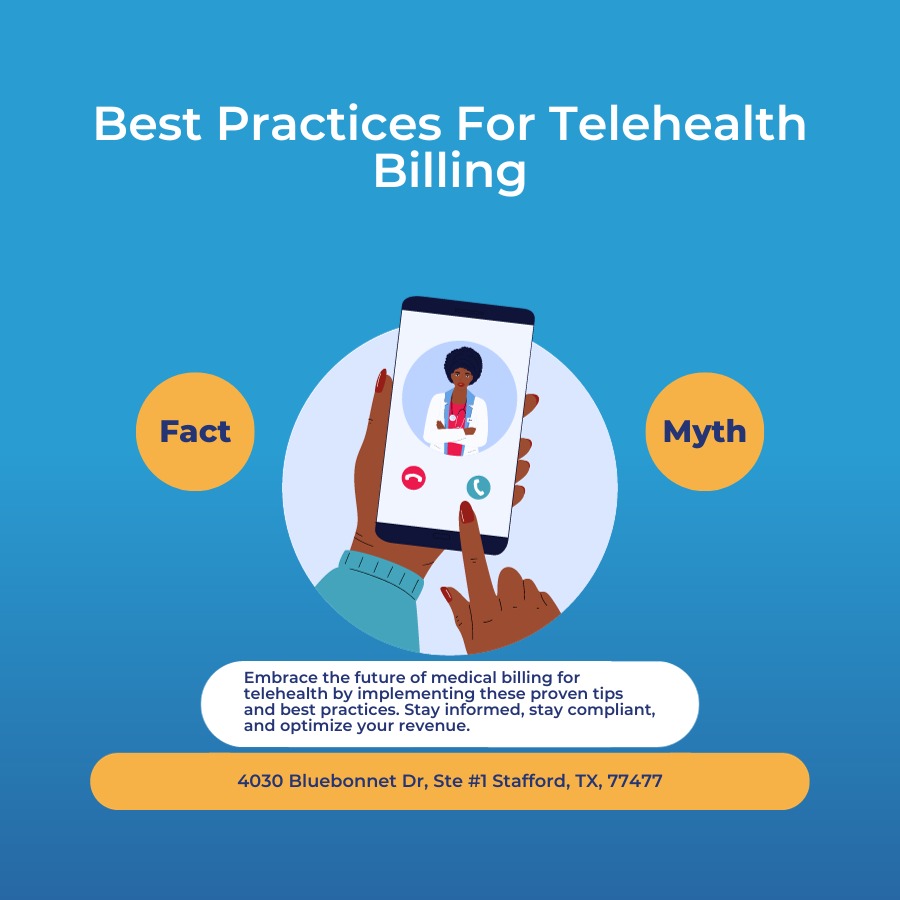- January 2, 2024
- Medical Billing
Table of Contents
ToggleIntroduction to Medical Billing for Telehealth
The world of healthcare has experienced a significant transformation with the rise of telehealth services. Telehealth allows providers to remotely deliver healthcare services to patients using telecommunications technology. As the popularity of telehealth continues to grow, it is crucial for healthcare providers to understand the intricacies of telehealth medical billing. In this article, we will explore the importance of understanding telehealth medical billing guidelines, provide an overview of the CMS telehealth medical billing guidelines for 2024, discuss key changes in Medicare telehealth guidelines for 2024, and present ten proven tips for providers to master medical billing for telehealth.
Importance of Understanding Telehealth Medical Billing Guidelines
Understanding telehealth medical billing guidelines is essential for healthcare providers to ensure accurate and timely reimbursement for their services. The guidelines vary depending on the payer, such as Medicare, Medicaid, or private insurance companies. Failure to comply with these guidelines can result in claim denials, delayed payments, or even legal issues. By familiarizing themselves with the specific billing requirements, providers can streamline their billing processes and maximize their revenue.
Mastering the Art of Telehealth Medical Billing: 10 Proven Tips for Providers
Overview of CMS Telehealth Medical Billing Guidelines for 2024
The Centers for Medicare and Medicaid Services (CMS) have been continuously updating their telehealth billing guidelines to adapt to the changing landscape of healthcare. In 2024, CMS has introduced several important changes that providers need to be aware of. These changes include expanding the list of eligible telehealth services, increasing reimbursement rates for certain telehealth services, and extending coverage for telehealth services in rural areas. It is crucial for providers to stay updated on these guidelines to ensure compliance and optimize their billing practices.
Key Changes in Medicare Telehealth Guidelines for 2024
Medicare, a federal insurance program that covers individuals aged 65 and older, has also made significant changes to its telehealth guidelines for 2024. Providers need to be familiar with these changes to effectively bill for telehealth services provided to Medicare beneficiaries. The key changes in Medicare telehealth guidelines for 2024 include expanding the list of eligible originating sites, allowing for more flexibility in the use of telehealth technology, and enhancing reimbursement for telehealth services. By understanding these changes, providers can navigate the Medicare system and maximize their reimbursement.
10 Proven Tips for Providers to Master Medical Billing for Telehealth
Mastering medical billing for telehealth requires a combination of knowledge, attention to detail, and efficient processes. Here are ten proven tips for providers to enhance their telehealth billing practices:
Familiarize Yourself with Telehealth Medical Billing Guidelines
Stay updated on the latest telehealth billing guidelines from CMS, Medicare, and other relevant payers. This will ensure that you are aware of any changes or updates that may impact your billing practices.
Verify Insurance Coverage for Telehealth Services
Before providing telehealth services, verify the patient’s insurance coverage. Ensure that telehealth services are covered by the patient’s insurance plan and obtain any necessary pre-authorizations to avoid claim denials.
Use the Correct Telehealth Modifier
When submitting claims for telehealth services, use the appropriate telehealth modifier based on the payer’s guidelines. This modifier indicates that the services were provided via telehealth and helps ensure accurate reimbursement.
Document Telehealth Services Thoroughly
Accurate and detailed documentation is crucial for telehealth medical billing. Document the patient’s consent for telehealth services, the services provided, and any relevant medical history or examination findings. This documentation will support the medical necessity of the services and facilitate reimbursement.
Submit Clean Claims
Ensure that your claims are clean and error-free before submitting them. Double-check all billing codes, modifiers, and patient information to minimize the risk of claim denials or payment delays.
Train Staff on Telehealth Medical Billing Processes
Educate your staff on the specific billing processes and requirements for telehealth services. Provide training on proper documentation, coding, and claim submission to ensure consistency and accuracy in medical billing practices.
Monitor Telehealth Reimbursement
Regularly monitor your telehealth reimbursement to identify any patterns or trends. Analyze denials and rejections to identify areas for improvement and take necessary steps to address any issues.
Engage in Regular Audits
Periodically conduct internal audits of your telehealth medical billing practices to ensure compliance and accuracy. Identify any potential coding or documentation errors and implement corrective measures to avoid future problems.
Seek Expert Advice
Consider consulting with medical billing experts or outsourcing your telehealth billing to a specialized billing service. Their expertise and experience can help optimize your billing processes and maximize reimbursement.
Stay Informed and Adapt
The landscape of telehealth medical billing is constantly evolving. Stay informed about the latest developments, changes in guidelines, and best practices. Continuously adapt your billing processes to ensure compliance and efficient revenue management.

Best Practices for Documenting Accurate Medical Billing for Telehealth Services
Accurate documentation is essential for successful telehealth medical billing. When documenting telehealth services, follow these best practices to ensure accurate medical billing:
- Clearly state the date and time of the telehealth encounter, along with the duration of the visit.
- Document the reason for the telehealth visit and the patient’s chief complaint.
- Include a detailed description of the services provided during the telehealth visit.
- Document any physical examinations or assessments conducted remotely.
- Record any prescriptions or treatment plans discussed during the telehealth visit.
- Obtain the patient’s consent for telehealth services and document it in the medical record.
- Maintain a separate section in the medical record specifically for telehealth encounters.
- Ensure that all documentation is legible, complete, and signed by the healthcare provider.
By following these best practices, providers can ensure accurate medical billing and support the medical necessity of the telehealth services provided.
Common Challenges in Telehealth Medical Billing and How to Overcome Them
While telehealth offers numerous benefits, it also presents unique challenges in the billing process. Providers may encounter the following common challenges in telehealth billing and can overcome them by implementing the following strategies:
- Navigating Payer Policies: Each payer may have different telehealth billing policies. Providers should thoroughly review and understand the telehealth medical billing guidelines of each payer they work with to ensure compliance.
- Technology and Connectivity Issues: Technical issues or poor internet connectivity can disrupt telehealth visits, leading to incomplete documentation or interrupted billing. Providers should have backup systems in place and train staff on troubleshooting common technical issues.
- Patient Eligibility and Insurance Coverage: Verifying patient eligibility and insurance coverage for telehealth services can be time-consuming. Providers should educate patients about their insurance coverage for telehealth and establish clear communication channels to address any questions or concerns.
- Coding and Documentation Errors: Incorrect coding and incomplete documentation can result in claim denials or delayed payments. Providers should invest in training staff on proper coding and documentation practices and implement regular audits to identify and correct any errors.
- Reimbursement Challenges: Some payers may have lower reimbursement rates for telehealth services compared to in-person visits. Providers should carefully review reimbursement schedules and negotiate with payers to ensure fair reimbursement for their services.
By proactively addressing these challenges, providers can overcome the barriers to successful telehealth billing and optimize their revenue.
Resources for Staying Updated on Telehealth Billing Guidelines
Staying updated on telehealth billing guidelines is crucial for providers to ensure compliance and maximize reimbursement. Here are some reliable resources to help you stay informed:
- Centers for Medicare and Medicaid Services (CMS) Telehealth Services webpage: CMS provides up-to-date information on telehealth billing guidelines, policy changes, and reimbursement rates. Visit their website regularly to access the latest resources.
- Professional Associations: Joining professional associations related to your specialty can provide access to valuable resources and updates on telehealth billing guidelines. These associations often offer educational webinars, newsletters, and networking opportunities.
- Medical Coding and Billing Publications: Subscribe to reputable medical coding and billing publications that regularly publish articles and updates on telehealth medical billing guidelines. These publications often provide practical tips and case studies to enhance your understanding of telehealth billing.
- Telehealth Billing Software Providers: Many telehealth billing software providers offer resources and educational materials on telehealth medical billing guidelines. Explore the resources provided by your chosen software provider to ensure you are utilizing all available tools and staying up-to-date.
By utilizing these resources, providers can stay informed about the latest telehealth billing guidelines and adapt their practices accordingly.
Telehealth Billing Services and Software Options
To streamline their telehealth billing processes, providers can leverage telehealth billing services and software options. These solutions can automate billing workflows, reduce administrative burden, and ensure accurate and timely reimbursement. Here are some popular telehealth medical billing services and software options:
- Telehealth-specific Billing Services: There are specialized billing services that focus on telehealth medical billing. These services have expertise in telehealth coding, documentation, and reimbursement, and can handle the billing process on behalf of the provider.
- Medical Billing Software with Telehealth Integration: Many medical billing software platforms now offer telehealth integration, allowing providers to seamlessly incorporate telehealth visits into their existing billing workflows. These software solutions often include features such as telehealth-specific coding, claim submission, and reimbursement tracking.
- Electronic Health Record (EHR) Systems with Telehealth Functionality: Some EHR systems have built-in telehealth functionality that includes billing capabilities. Providers can use these systems to document telehealth visits, generate claims, and track reimbursement within a single platform.
- Revenue Cycle Management (RCM) Solutions: RCM solutions encompass the entire billing process, from patient registration to claim submission and payment reconciliation. These solutions often have telehealth-specific modules that optimize the telehealth billing workflow.
Providers should evaluate their specific needs and budget to determine the most suitable telehealth medical billing service or software option for their practice.

CPT Codes and Details Telehealth Medical Billing
| CPT Code | Description | Additional Details |
| 99201-99205 | New Patient Office or Other Outpatient Visits via telehealth | Complexity varies based on the level of the visit. |
| 99444 | Online E/M Service for Established Patient (5-10 minutes) | Brief online evaluation and management for established patients. |
| 99446-99449 | Interprofessional Telephone/Internet Consultations | Consultations between healthcare professionals via telehealth. |
| G2010 | Remote Evaluation of Recorded Video and/or Images | Remote evaluation of recorded video/images for established patients. |
| G2012 | Brief Communication Technology-Based Service (e.g., Virtual Check-In) | Brief communication technology-based service initiated by the patient. |
| 98966-98968 | Telephone Assessment and Management Service | Telephone assessment and management services by healthcare professionals. |
| 99421-99423 | Online Digital Evaluation and Management Services for Established Patients | Online digital evaluation and management over a specified cumulative time. |
| 90832-90834 | Psychotherapy Services via telehealth | Psychotherapy services provided remotely, varying in duration. |
| 99483 | Assessment of and care planning for a patient with cognitive impairment | Assessment and care planning for patients with cognitive impairment. |
| 99452 | Initial remote physiologic monitoring treatment management service | Initial remote physiologic monitoring and treatment management. |
Conclusion: Embracing the Future of Medical Billing for Telehealth
As telehealth continues to reshape the healthcare landscape, mastering the art of medical billing for telehealth is crucial for providers. By understanding telehealth billing guidelines, staying updated on the latest changes, and implementing proven tips and best practices, providers can navigate the complexities of telehealth billing and optimize their revenue. With the right resources, tools, and strategies in place, providers can embrace the future of medical billing for telehealth and deliver high-quality care to patients, regardless of geographical barriers.
What are the key challenges in telehealth medical billing for healthcare providers?
Telehealth billing poses challenges such as navigating reimbursement policies, which may vary across payers, dealing with coding complexities specific to telehealth services, and ensuring compliance with ever-evolving regulations in the healthcare industry.
How can healthcare providers maximize reimbursement through telehealth services?
Providers can optimize reimbursement by implementing accurate coding for telehealth services. This involves using specific Current Procedural Terminology (CPT) codes and modifiers designated for telehealth visits. Staying informed about billing guidelines, adopting best practices for claims submission, and conducting thorough follow-ups are also crucial.
Are there specific coding considerations for telehealth medical billing?
Yes, there are specific CPT codes and modifiers designated for telehealth services. Accurate and appropriate coding is essential to ensure that payers recognize and reimburse telehealth visits appropriately.
What are some common mistakes to avoid in telehealth billing?
Common mistakes include incorrect coding, incomplete documentation, and failure to verify patient eligibility. Providers must address these issues to prevent reimbursement delays and denials.
How does insurance verification play a role in telehealth medical billing?
Thorough insurance verification is crucial in preventing claim denials. Verifying patient coverage before providing telehealth services ensures that providers are aware of potential reimbursement issues and can take proactive steps to address them.
Are there technology solutions that can aid in telehealth billing?
Yes, integrating billing software with telehealth platforms streamlines the billing process. Automated claim submissions, real-time eligibility verification, and enhanced accuracy contribute to improved billing efficiency and reimbursement outcomes.
What documentation is essential for successful telehealth medical billing?
Comprehensive documentation of telehealth visits is essential. This includes thorough records of patient history, examination details, treatment plans, and any other pertinent information. Proper documentation supports accurate billing and compliance.
How can providers stay updated on changing telehealth medical billing regulations?
Providers can stay informed by regularly monitoring official healthcare regulatory websites, participating in industry webinars, and engaging with professional associations. This ongoing education is crucial for adapting to changes in telehealth billing regulations.
Can outsourcing billing services benefit healthcare providers engaged in telehealth services?
There is no doubt that when healthcare providers engage in telehealth, collaborating with a reputable company like Secure MSO increases the efficiency of billing processes. Relying upon experienced professionals provides a particular approach that not only boosts accuracy, but it also significantly reduces the amount of work required of in-house staff. The simplified reimbursement procedure becomes a strong asset, enabling healthcare providers to target their attention and resources to supply the best possible care to their patients.

Embrace The Future Of Medical Billing for Telehealth
Embrace the future of medical billing for telehealth by implementing these proven tips and best practices. Stay informed, stay compliant, and optimize your revenue.
Book An AppointmentCall Us Now!
